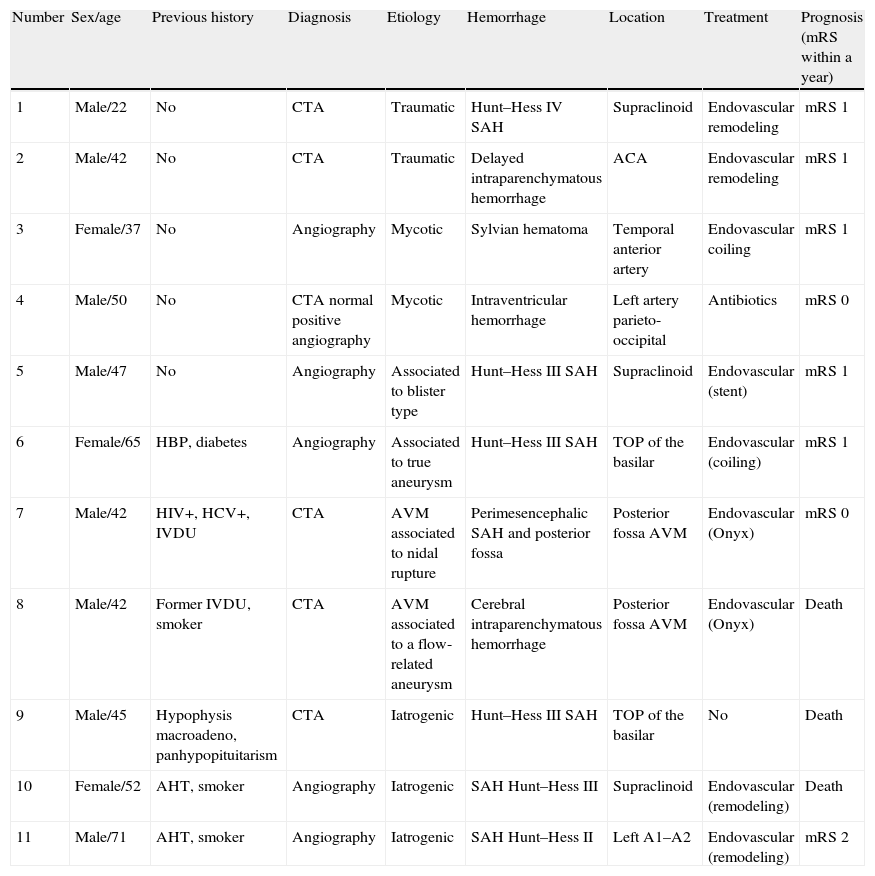To present our experience in the diagnosis and intravascular treatment of cerebral pseudoaneurysms.
Material and methodsWe present 11 pseudoaneurysms (2 traumatic, 2 mycotic, 3 iatrogenic, and 4 with other causes). We analyze the methods and diagnostic criteria, radiological and clinical outcome, the criteria used in making decisions about treatment, the method of treatment, and the complications.
ResultsDigital subtraction angiography is the gold standard for the diagnosis of cerebral pseudoaneurysms; the diagnostic criteria in the literature include: aneurysms with early morphological changes and distal aneurysms or proximal aneurysms associated with another distal one, in the context of the right symptoms and signs. In the nine patients treated with endovascular techniques, the treatment objective was achieved and rebleeding did not occur.
ConclusionsIn cases with clinical suspicion of a pseudoaneurysm, the patient should undergo angiography. This is especially important in patients with inexplicable cerebral hemorrhage and in those with septicemia. CT angiography and MR angiography have good diagnostic accuracy and can replace conventional angiography. However, the treatment of choice is endovascular and treatment should not be delayed unless access to the pseudoaneurysm is impeded, usually due to severe cerebral vasospasm.
Presentar nuestra experiencia en el diagnóstico y tratamiento intravascular de los seudoaneurismas cerebrales.
Material y métodosPresentamos 11 casos de seudoaneurismas (2 traumáticos, 2 micóticos, 3 iatrogénicos y 4 asociados a otras causas) en otros tantos pacientes y analizamos los métodos y criterios diagnósticos, la evolución radiológica y clínica, los criterios tomados en cuenta para la decisión terapéutica, el método de tratamiento y las complicaciones.
ResultadosEl método de referencia para el diagnóstico es la angiografía por sustracción digital y los criterios diagnósticos en la literatura médica incluyen: aneurismas con cambios morfológicos precoces, aneurismas distales o aneurismas proximales asociados a otro distal, en el contexto clínico adecuado. En los 9 pacientes tratados mediante técnica intravascular se consiguió el objetivo del tratamiento, evitar el resangrado.
ConclusionesAnte la sospecha clínica de un seudoaneurisma todo paciente debe ser valorado mediante arteriografía, principalmente aquellos que presentan hemorragias cerebrales inexplicables y los pacientes con septicemia. La angiografía mediante TC o mediante RM puede sustituir a la arteriografía con una buena rentabilidad diagnóstica. El tratamiento de elección debe ser el intravascular de primera intención y no demorarse excepto que exista una razón que impida el acceso al seudoaneurisma, normalmente un vasoespasmo cerebral grave.
Artículo
Comprando el artículo el PDF del mismo podrá ser descargado
Precio 19,34 €
Comprar ahora













